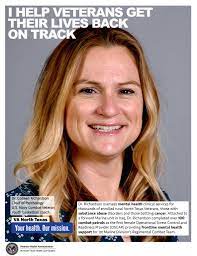WASHINGTON, DC – During her four years of active duty with the Navy, Colleen Richardson, PsyD, saw the immediate effects of trauma first-hand. In 2008, as the first woman Operational Stress Control and Readiness Provider embedded with the 1st Marine Division’s Regimental Combat Team, the clinical psychologist provided mental health care to servicemembers on the front lines in Iraq.
When she returned stateside, she directed mental health care at Wounded Warrior Battalion West, which serves wounded servicemembers west of the Mississippi.
While she loved her time with the Navy, three years of combat deployments followed by a year of coordinating the care of so many injured sailors had taken its toll.
“At that point…to be very honest, I was completely burnt out from a mental health perspective myself,” Richardson admitted.
Leaving active duty, she moved on to the one place, other than the Navy, where she thought she would fit in–the VA. Starting as a staff psychologist, she quickly progressed up the ranks until, in March 2021, she took on the role of Executive Director of VA’s Caregiver Support Program.
“Congress came to the table [in 2010] and decided we have all of these men and women who are so severely injured…And now we’ve got moms, dads, brothers, sisters, husbands, and wives giving up their careers to take care of them,” Richardson said, describing the program’s beginnings. “We’ve never seen anything like this. Men and women surviving these kinds of injuries.”
The program was designed to provide training, education, peer support and, for those enrolled in the comprehensive assistance arm of the program, health insurance and a stipend.
While the program was originally limited to caregivers of veterans injured after September 11, 2001, the 2018 MISSION Act expanded it significantly. Starting in October 2020, the program was opened to veterans who incurred a serious injury while on duty prior to 1975. And in October 2022, it will begin accepting applications for veterans injured between 1975 and 2001.
The result has been an unprecedented expansion of comprehensive assistance applications and the number of people the program is supporting.
“In the last two years, we have seen an over 400% increase in the number of applications to this program,” Richardson declared. “And I fully anticipate when we open this up to the Persian Gulf War vets that we will see a significant increase in the volume of applications yet again come this October.”
The last year has focused not only on processing applications within a 90-day window, but making sure that the acceptance rates and the experience for applicants are standardized across VA.
“We don’t want a caregiver to walk into one VA and get one decision and walk into another one and get another,” Richardson said.
That means getting the 2,300 staff across the country who support the program to be on the same page.
A Challenge
“We’re getting there, but it’s a challenge,” she explained. “The approval rates have gone up significantly. An average of about 32-38% of those who apply and make it to the decision team get into the program.”
But while processing applications is a big part of the job, it’s finding ways to provide more and better support to caregivers that Richardson and her staff are passionate about. They regularly hold listening sessions with caregivers across the country to learn what the program is doing well, and where it can grow.
Thanks to that feedback, this year the program is standing up mental health clinicians specifically tasked with supporting caregivers. The clinicians will be located at VISN headquarters and will be available to provide remote support to as many caregivers as possible.
The Caregiver Support Program will also be funding respite workers for caregivers who need a break but cannot leave the veteran they care for alone at home.
“A lot of our caregivers [are] so busy taking care of everybody else that they’ve forgotten to take care of themselves,” Richardson said.
“We want to provide whatever support it is that these caregivers need to be successful,” she added. “We want them to not just have a good experience, but a great experience.”
Richardson is adamant that the program and her staff view the veteran and caregiver as individuals with unique needs, and, as the program expands yet again this October, to not get blinded by the sheer numbers of new applicants.
“It’s so easy when you have an application, and it’s just a piece of paper to say, ‘Sorry, you don’t meet the qualifications,’” she said. “But there is a human and story behind every single application that comes in our door. I’m married to a Marine combat veteran. These are the stories of our lives, of our friends.”
Some of those stories are very familiar to Richardson. Looking at program applicants and participants, she sometimes comes across familiar names and reads descriptions of familiar events–servicemembers and missions that Richardson was present for during her time in Iraq.
“I’ll go ‘Oh my God, I was there that day. He’s in our program now?” she said.
And while the press of new applicants might be challenging in the months to come, Richardson regularly reminds her staff that their job is not to be gatekeepers, but to give every person eligible the best support possible.
“I keep coming back to the connection. Those stories,” she said. “Why are we here? You have to bring people back to that why.”


